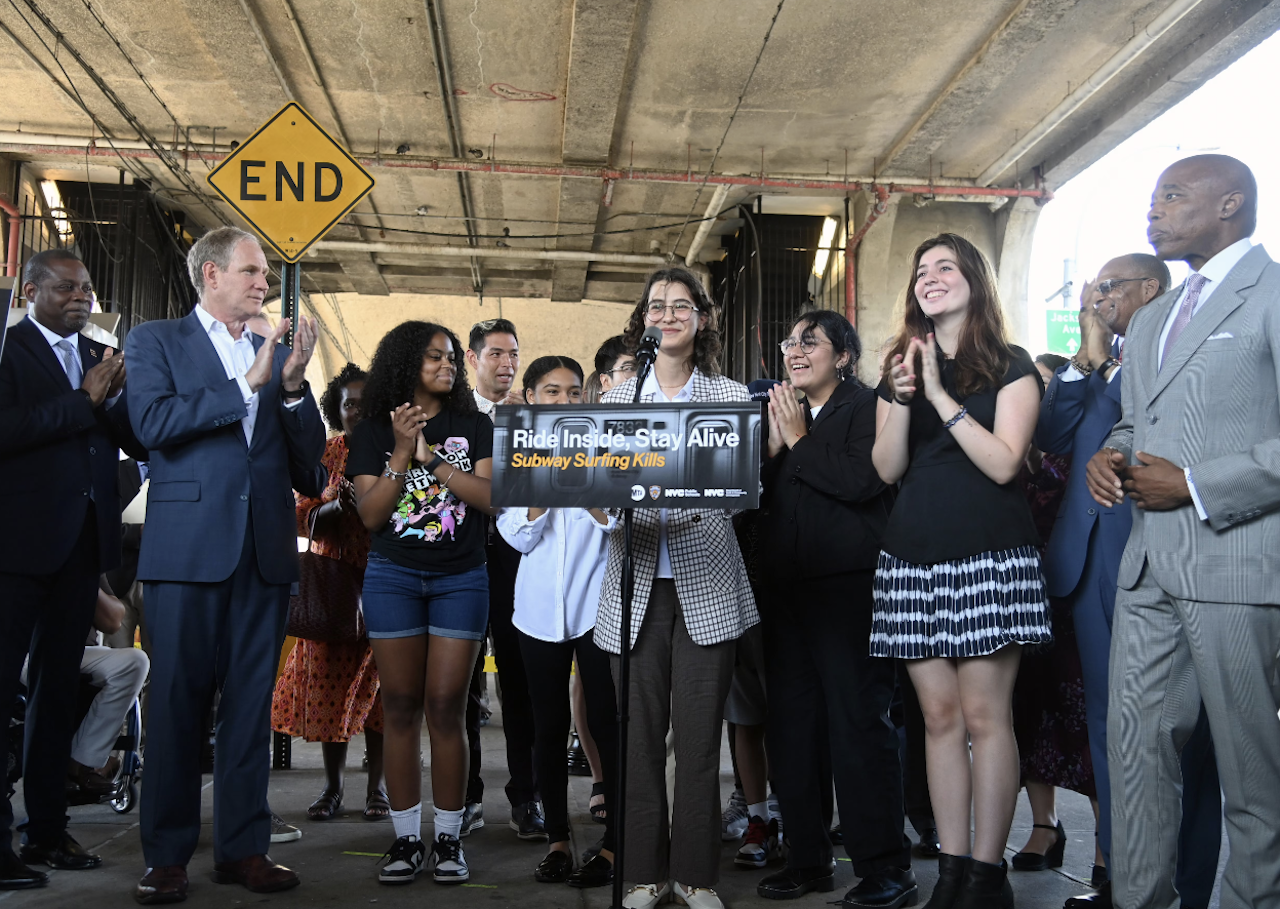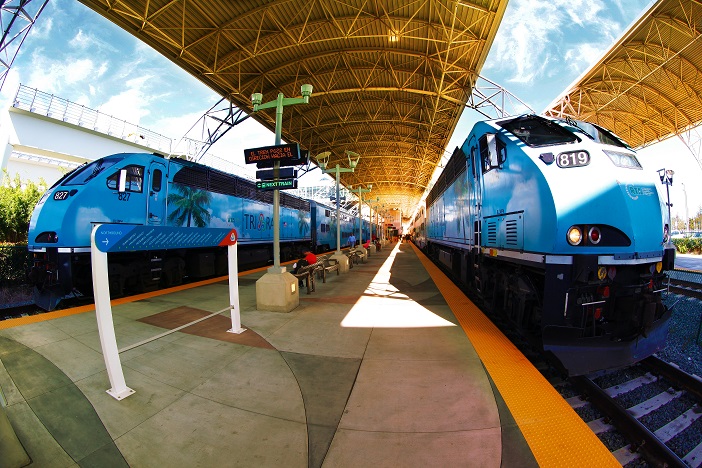
Transit Briefs: NYMTA, Amtrak, Tri-Rail, NFTA, PRT
Written by Carolina Worrell, Senior Editor
NYMTA photo
The New York Metropolitan Transportation Authority (MTA) combats “subway stupidity.” Also, Amtrak resumes service on the Adirondack Line; Tri-Rail takes added safety measures as it heads to downtown Miami; the Niagara Frontier Transportation Authority (NFTA) launches a new MetGo app; and Pittsburgh Regional Transit (PRT) deploys mobile ticketing and validators across light rail powered by Masabi.
NYMTA
The New York MTA on Sept. 5 unveiled a new comprehensive, multi-channel public information campaign against subway surfing in partnership with the New York Police Department (NYPD), New York City Public Schools, and the New York City Department of Youth & Community Development (DYCD).
According to MTA, the new campaign, titled “Subway Surfing Kills – Ride Inside, Stay Alive,” centers around and is designed and spoken by New York City teenagers—putting the youth voice front and center in a peer-to-peer effort to deter this dangerous behavior among young people.
The NYPD is contributing to the campaign by deploying officers to stations on outdoor elevated lines and by conducting home visits with youths who have been observed riding outside of trains.
The campaign announcement was made outside the 33 St–Rawson St (7) subway station—the site of a tragic incident on Thursday, June 29, in which a 14-year-old from Brooklyn died after falling while attempting to ride on top of a 7 train. The 7 Line experiences the most subway surfing incidents in the transit system, according to the agency.
According to MTA data, dangerous riding outside of subway trains occurs predominantly in the afternoons during warmer months when school is in session, indicating that it has essentially become a dangerous from of after-school activity.
In anticipation of an uptick in September upon the start of the new school year, the multi-layered campaign has been launched across various communication platforms, to include public service announcements in stations recorded by students; digital signage across stations; student-created graphics and animations; posters and banners across stations and distributed in schools; physical palm cards distributed at schools and in stations; school swag including planners, pens and pencils, notepads and sticky notes; social media posts across platforms including TikTok, Instagram and YouTube in the form of posts, reels/shorts and influencer collaborations; distribution of new student MetroCards accompanied by a “Ride Inside, Stay Alive” palm card, and anti-surfing messages on the back of some MetroCards for sale in station MetroCard vending machines.
The MTA partnered with NYC Public Schools and DYCD to identify students from schools across the city who created the new campaign. Students from the High School of Art & Design in Manhattan created graphics, animations and artwork that will be seen throughout the subway system and on social media.
A group of middle school and high school students from the Academy of American Studies in Queens, the High School of Art and Design in Manhattan, I.S. 318 in Brooklyn, and DYCD summer programs went to MTA headquarters last month to record announcements explaining the dangers of riding outside of trains. Eight announcements, recorded in both English and Spanish, will be heard throughout the transit system beginning this week.
Because teenagers frequently post videos of themselves surfing to social media, the MTA has been asking that social media companies, including Meta, Google and TikTok reduce access to these videos. Since this past spring the social media companies have removed more than 3,000 videos and photos showing subway surfing. Those companies also are making space on their platforms available to help distribute the new messaging campaign.
The MTA says it continues to meet with school administrators to “ensure students are learning about the dangers of riding outside of train cars in school.”
In 2023, there have been five fatalities due to suspected subway surfing, compared to five total fatalities between 2018 and 2022. The MTA has documented more than 450 instances of people riding outside of trains between January and June in 2023.
“Riding outside a train car is subway stupidity and never ends well,” said MTA Chair and CEO Janno Lieber. “We are begging parents to speak with their children, and teachers to talk to their students about what can seem like a game but can end in tragedy. I want to thank Governor Hochul, Mayor Adams and our City agency partners for their strong support in raising awareness about the dangers of this so that we can prevent any more young lives being senselessly lost.”
Amtrak
Following a two-month suspension of service, Amtrak’s Adirondack Line train route, which serves Montreal and New York City and points in between, will tentatively resume service on Sept. 11, according to a Press-Republican report.
“We, of course, welcome indications that Amtrak will resume the Adirondack service between New York and Montreal, tentatively on Sept. 11,” said President of the North Country Chamber of Commerce Garry Douglas.
“However, we urgently need for Amtrak and CN to define the track improvements needed and how and when they will be undertaken so we can hopefully avoid future summer stoppages.”
According to the Press-Republican report, Amtrak’s Adirondack Line was shut down in April 2020 at the outset of the COVID-19 pandemic and “stayed dormant until this past April when it resumed running.”
“But in late June, it was shut down again following the imposition of a 10 mph speed limit by CN on its trackage north of the Canadian border anytime the external temperature exceeded 86 degree Fahrenheit,” according to the report.
Although no official word of the Adirondack Line resuming service came from Amtrak, state leaders reacted to the news that it would be, Press-Republican reported.
“We are still waiting on the details for when they will re-open, with a tentative date set for Sept. 11. However, CN and Amtrak need to release their long-term plans to make the necessary fixes to the tracks so that this doesn’t happen again next year,” said Assemblyman D. Billy Jones (D-Chateaugay Lake).
Tri-Rail
Two safety systems, including Automatic Train Control (ATC), have been installed in Tri-Rail trains to combat the issue of integrating grade-level tracks with passenger vehicle and pedestrian traffic in downtown Miami, according to a Miami Today report.
According to the report, a proposed MiamiCentral terminal schedule has been reviewed and found compatible by analysts for Brightline, with which Tri-Rail would share the terminal, and is currently being reviewed by the Florida East Coast (FEC) Railway, said South Florida Regional Transportation Authority (SFRTA) Executive Director David Dech.
“We will most likely repeat the efforts of providing dynamic signs and have staff at crossings when we prepare to start service,” SFRTA Public Affairs Director Victor Garcia told Miami Today. “We will have a media advisory and share our message with community partners to help us spread the word.”
“As part of our commitment to the community, we’re providing dynamic messaging signs informing the traveling public to expect an increase in train traffic along the 23 crossings.
“Furthermore, we’ve deployed additional employees at the crossings equipped with train safety information. We have worked very closely with our partners to ensure that all tests were conducted with a variety of safety precautions, and we were successful in completing all tests safely and without incident.
“We are continuing to work with our partners as we enter the next training phase,” Garcia said.

According to the Miami Today report, SFRTA has been working alongside Brightline and FEC Railway in coordinating runs by non-revenue Tri-Rail trainsets between the South Florida Rail Corridor and MiamiCentral, traveling on the eight miles of FEC track that connects the Tri-Rail with downtown Miami.
“We did our first tests and training in June and our last set was completed last week,” said Garcia. “During these tests we performed our Designated Supervisor of Locomotive Engineers qualification rides as part of our training agreement. Tri-Rail trains successfully operated on the viaduct into MiamiCentral, where the trains fit the platforms perfectly.”
“The long-awaited $70 million tax-funded project to bring Tri-Rail into downtown was to be finished by 2017,” Miami Today reported last month. The new launch date, Dech said, is by the end of 2023 or early next year.
NFTA
NFTA on Sept. 5 announced the launch of its MetGo app, providing riders with a new way to pay.
According to the agency, customers can now download the MetGo app, which works on an account-based system. Riders can load money on the app and use it to pay the fare for Metro services systemwide.
According to NFTA, benefits include ease of access, as well as fare capping, which “ensures riders won’t pay more than $5 a day no matter how much they ride the bus or rail.”
“Making public services as easy to access as possible is a top priority for us,” said NFTA Director Public Transportation James Morrell. “The launch of this app marks a major milestone as we enter into implementing this new state-of-the-art fare collection system.”
The Metgo app is now available on both iPhone and Android platforms.
Riders who do not have access to a smartphone can purchase a reloadable MetGo card for only $2.00 at the NFTA’s customer service center at 181 Ellicott Street. Cards are also available for purchase at participating 7-Eleven, Walgreens, and Walmart stores.
PRT
PRT announced Sept. 6 that mobile ticketing, powered by London-based Masabi, the company delivering the smarter ticketing through its open platform Justride, is now available on the agency’s network of 700 buses, 80 railcars, and both the Monogahela and Duquesne inclines.
According to PRT, the latest installation was enabled using the light rail certified Justride Validator, which conforms with NFPA 130, the National Standard for Fire Prevention for Fixed Guideway Transit and Passenger Rail Systems, a federal requirement for installation of equipment in rail vehicles. According to the agency, PRT is first in the world to roll out the Light Rail Certified Just Ride Validator, which was specifically designed to operate in the tightly regulated light rail system.
Starting today, riders can purchase tickets using the Ready2Ride app, which is available for download from the Apple App Store and Google Play. PRT has also programmed its existing ticket vending machines to allow riders to use cash or payment cards at vending machines to load money onto their mobile ticketing account. Mobile ticketing is currently used for 13% of PRT’s trips.
“We are thrilled to finally launch mobile ticketing across our entire network,” said PRT CEO Katharine Kelleman. “Now, whether you ride the bus, rail, either incline, or across different modes to get where you’re going, you’ll have access to the best our system has to offer.”
“By launching a light rail-certified variant of Justride Validator, we can now extend mobile ticketing with PRT across their entire transportation network,” said Masabi CEO Brian Zanghi. “Building on the more than 700 validators that we already have live across the agency’s buses, riders can now use mobile ticketing for multi-modal journeys of all types—dramatically increasing the ease by which they can travel around the county.”
“Mobile ticketing is a perfect example of how the use of technology can be used to simplify our system, increase access, and improve public transit,” said PRT Chief Innovation Officer Jeffrey Devlin. “Our riders have been asking for this for years, and we’re genuinely excited to hear their feedback.”
PRT says it is also finalizing agreements that will allow riders to add money to their mobile ticketing accounts at several local retailers.



